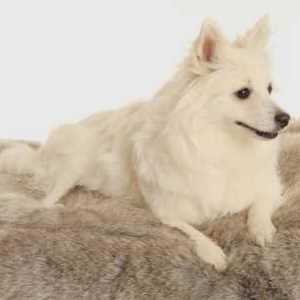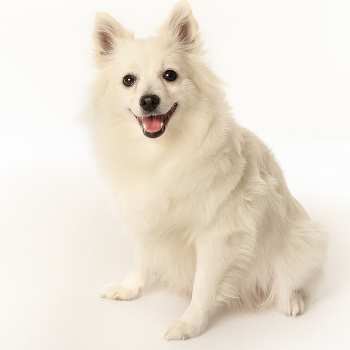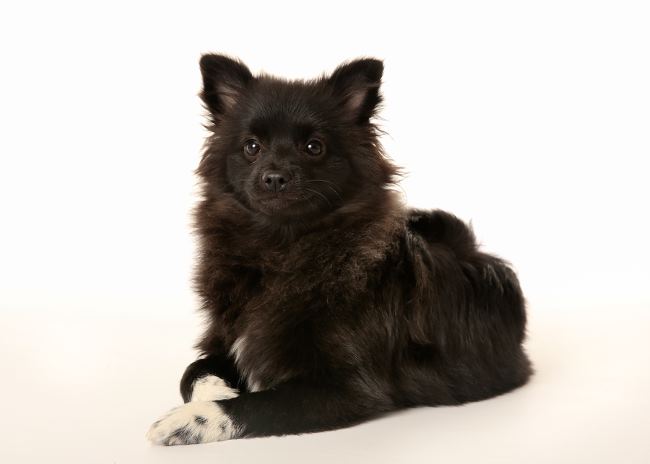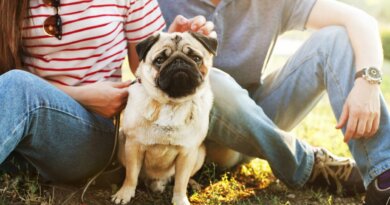Volpino Italiano: Complete Dog Breed Profile
By Janice Jones |Last Updated 06-29-2023
The Volpino Italiano is the classic small dog with a big
personality. They are affectionate,
gentle and above all fearless.
They are curious and playful while still protecting their
family. Their loyalty is unmatched, and one can see why historically these dogs
became so popular both to royalty and the common man in Italy.

They are an energetic, active breed but don’t require as much exercise as you might expect. The Volpino Italiano can excel in dog sports if that’s something of interest to you. Agility, nose work, and rally are three good choices for this breed.
The Volpino Italiano is a type of Spitz dog that resembles the Pomeranian, Japanese Spitz, American Eskimo, and German Spitz Klein very carefully and if fact, it takes a right eye to see the differences.
Similar But Different Dog Breeds
 Volpino Italiano
Volpino ItalianoThe Volpino Italiano is a Spitz-Type Dog
Although each of the dogs above bare a close resemblance,
they are all distinct dogs. The spitz breeds are a group of ancient dogs often
called the northern breeds.
They likely
originated in the Arctic or Siberia judging by their thick double coats, but
wherever they started out, the climate was frigid.
Spitz dogs have many physical traits in common such as
pointed ears and muzzles that resemble a fox.
All have thick plumbed tails that they carry over their back and double
coats.
The Volpino Italiano and the Pomeranian: Similarities and Differences
The Volpino Italiano resembles a white or black Pomeranian,
but are somewhat larger than the Pom with
a height of 9 to 11 inches (25 to 30 cm) and weigh between 9 and 12 pounds.
(4.08 to 5.44 kg).
Both breeds have the
classic Spitz features of triangular ears, thick double coat, plumbed tail, and similarly shaped muzzle.
Quick Facts
Other Names Used: Italian Pomeranian, Italian Spitz, Florentine Spitz, Cane di Firenze, Volpino, Vulpino Romano, Cane del Quirinale, (Romano and Quirinale refers to ancient Roman past)
Victorian authors have also used the term “lupette” or lupetties’ – meaning, small wolf.
Affiliation: UKC, FCI, AKC declined admittance because they felt these dogs were too much like the Pomeranians.
Size
Height: 10-12 inches (25-30 cm)
Weight: 8 to 12 pounds (3-5 kg)
Coat Type: Harsh outer coat and soft inner coat with hair that sticks out from the body; straight and very fluffy
Colors: The most common is white, but they can also be black, champagne, fawn, honey, red, sable
Country of Origin: Italy
Activity Level: Active
Litter Size: 3-5 puppies
Life Expectancy: 14-16 years
Good with Children: Good with older children but may not be safe around very young children
Good with other pets:
Personality/Temperament
Explanations for At a Glance Ratings
- Playfulness: Most=5 Less=1
- Affection: Most=5 Least=1
- Friendliness Towards Strangers: Most=5 Least=1
- Good with Children: Good=5 Not Good=1
- Good with Other Dogs: Good=5 Not Good=1
- Good for First Time Owners: Good=5 Not Good=1
- Amount of Exercise Required: Much=5 Minimal=1
- Ease of Training: Easy=5 Difficult=1
- Watch Dog Ability: Excellent=5 Poor=1
- Grooming Needs: Extensive=5 Minimal=1
- Shedding: Heavy Shedding=5 Minimal Shedding=1
- Cold Tolerance: Cold Well Tolerated=5 Poorly Tolerated=1
- Heat Tolerance: Heat Well Tolerated=5 Poorly Tolerated=1

This is a loyal,
affectionate breed that bonds quickly
with the members of his family. As a
good family pet, they aren’t as clingy as some other breeds and often do not
suffer from Small Dog Syndrome the way others do.
They get along reasonably well with other pets including
cats.
Are Volpino Italiano Dogs Good with Children?
They are very playful and curious making them ideal for
families with children. Due to their
small size, supervision is always necessary
when small children are interacting with this breed.
So this breed is perfect for families who have respectful
children who can gently handle them.
Are These Dogs Good For Apartments?
While the size of these dogs lends themselves nicely to
apartment life, their barking tendencies may make them unsuitable. They are by nature excellent watch dogs and
will frequently bark if there is much
activity going on outside their window.
Barking can be a problem to close neighbors, but it is a
behavior that can be modified with time.
Teaching the command, “Quiet” at an early age will help him
control some of the tendency to bark.
How Much Exercise Does these Dogs Need?
The Volpino Italiano is an energetic breed that is active
both indoors and out. Even with all of
that energy, they can get by with frequent play periods and a short walk or two
daily.
They are adaptable and will begin to take on the
characteristics of their family, so some are more active than others depending
on the activity level of the owners.
Is it Easy to Train a Volpino?
Just like all dogs, a puppy can begin training the day you
bring him home. He will need early
socialization and manners training to help him become accustomed to your home
rules.
House Training should begin early
too, and consistency will help speed up
the process. Puppy kindergarten classes
also also worthwhile and teach not only basic
skills but also provide additional socialization opportunities.
They are very smart
and learn quickly. A positive approach
is always the best way to train a puppy and voice commands, or clicker train can work very well.
The negative side of a highly intelligent dog is his ability
to outsmart you. Sometimes stubborn,
other times just clever, you will need to
be alert to any tricks he’d like to train you to do.
History
The spitz type of dog has been in existence for at least
5000 years dating back to the Stone Age. Early people found them very useful
for a wide variety of tasks and soon domesticated them to pull sleds, guard
flocks, serve as watch dogs and companions.
Anthropologists have found specimens in the foundation piles
of European lake dwellings dating back to 4000 BC. Engravings and bits of pottery artwork have
been located in Greece and dated to 400-470 BC.
As humans migrated, they took their dogs and the Spitz type
dogs spread into Europe and North America.
The original ancient spitz type dogs became the foundation for many of
the dogs we know today including the German Spitz, Keeshond, Pomeranian,
American Eskimo, and Japanese Spitz.
As an authentic
Italian breed, these dogs have enjoyed a lifestyle of companionship to the
royalty. Peasants, artists including
Michelangelo and merchants also found fancy with these dogs.
From pulling carts to guarding the merchandise, travelling
merchants found them useful. Farmers
found favor in their ability to awaken the sleeping mastiffs who were supposed
to defend the livestock.
Italian shepherds and goat herders relied on them to guard
their flocks, and as mentioned earlier,
these dogs keep Michelangelo company while he worked on the ceiling of the
Sistine Chapel.
During the Roman Empire, these dogs became favorite
companions of the ladies who provided them with ivory bracelets and jeweled
collars of Italy.
During a holiday in Florence in 1888 Queen Victoria of
England became captivated by the breed’s appearance, and from then on, the breed was named the Florentine Spitz.
Despite the popularity in Italy, by the mid 20th century
only a handful of these dogs were registered with the Italian Kennel Club
(ENCI). Ten years later, people thought
that the dogs had become extinct.
Much of the decline can be traced to the political situation
of the day. The Monarchy was abolished, and
people lost interest in dogs that were primarily those of nobility.
Another factor leading to the declining numbers was the
development of the Pomeranians in England.
Through downsizing, the Pom nearly replaced the Volpino Italiano because
everyone prefered the smaller sized dog.
In 1984, the ENCI began a program to restore the breed. While they are still scarce even in Italy, their numbers are increasing there and in
other European countries.
In the U.S. this breed is not recognized by the AKC, but
they are regstered by the UKC and FCI.
Coat & Grooming
Despite his thick double coat,
the Volpino Italiano does not require the kind of extensive care that you may
expect.
They do shed, usually seasonally so additional attention to
the coat during times of shedding will be required. Sometimes even daily
brushing during these times will be necessary.
Frequent brushing will help keep hair off of
your carpets and furniture. Bathing during this time with a good shampoo will
also help with the shedding.
Otherwise, he will need weekly brushing to assure that the
undercoat does not mat. The best type of
brush to use is a pin brush and metal comb.
You will also want to invest in a slicker brush, a dematting comb, and detangling spray.
Bathe when dirty but too frequent bathing can rob the coat
of natural oils and make the hair very dry.
The hair between his paw pads continues to grow so that will need to be trimmed to prevent longer
hairs from becoming matted. They also
have a tendency to track in mud and dirt especially the white dogs. A soft rag or moistened wipe can get the dirt
off quickly.
Ears should be checked weekly and cleaned if necessary with
a good ear cleaner. If there is a bad
odor, there is a likelihood of an infection, and
a vet should be called.
Teeth should be brushed weekly, and nails trimmed every couple of weeks.
Health Concerns of the Volpino Italiano
The Volpino is a healthy breed that can live 14 to 16 years.
As with other dog breeds, there are a few genetic conditions that have been identified including Primary Lens
Luxation, painful genetic eye disease, and Patellar luxation, a problem with the
kneecap.
You can avoid some problems by searching for a reputable
breeder that screens for some genetic diseases.
With that said, genetics has a way of tricking us so even the best
breeders will have puppies that develop inherited diseases.
A good health guarantee at the time of sale
will help protect you should anything go wrong.
Other than genetic problems, puppies need to be protected through vaccinations and wormings.
Protection from external parasites and heartworm disease is also essential.
A high quality balanced diet will also keep your puppy
healthy Generally small dogs need approximately 25 to 30 calories per pound per
day, and this usually works out to 3/4 to 1 cup daily divided into two meals
depending on the type of food.
Puppies
will need 3 meals per day.
For the Volpino Italiano Lover
Pros of Living with A Volpino Italiano
- Playful, loving, intelligent
- Good with older children
- Easy to train
- May be a good choice for apartment dwellers
Cons:
- Sheds year round
- A Very active breed that needs an energetic owner
- Amazing escape artists
- Cannot be left alone all day with consequences
- Not good for families with very young children
Did You Know…
- Michelangelo had one of these dogs as his pet and you can see a portrait in the Sistine Chapel paintings.
- On a holiday to Florence Italy, Queen Victoria obtained a couple of Volpino Italiano in 1888.
Looking For Some Very Cute Volpino Italiano Photos?
We love photos as much as you and we found this Pinterest page has an amazing number of these rare dogs.
Share Your Experience Living with a Volpino Italiano
I love to receive comments and
feedback from my site’s visitors—everything helps make this site even
better. Why not join in and share your
thoughts about what you just read.
If you found this article or site
helpful or enjoyable, I always appreciate a “Like” or “Share” or a +1.
Your “Likes” on our Facebook page
help us too.
Come back soon,
Janice
Does This Article Deserve Your Thumbs Up?
We always appreciate your support and encouragement. Your thumbs up means so much to us. Please like this article.
If you find this page or any page on Small Dog Place Helpful, or Useful in anyway, I’d love it if you would click the small heart found on the bottom right of each page.
You can also share or bookmark this page — just click on the:

Free Monthly Newsletter
Sign Up for Our Free Newsletter and get our Free Gift to You.
my E-book, The Top 10 Mistakes People Make When Choosing a Dog (and how to avoid them)




